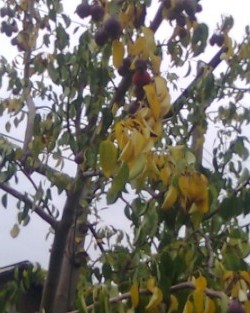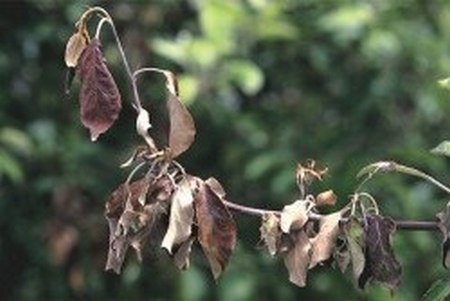Leaves fall from trees during the summer for many reasons. Let's name a few of the most common ones.
Due to soil and atmospheric drought.
When there is insufficient water supply, trees with a shallow root system (on dwarf rootstocks) are the first to suffer. They do not have long taproots that draw moisture from deeper layers of the soil.In hot weather, when the air temperature is + 30 degrees, and the ground, not protected from the hot sun by mulch, heats up to 50 degrees, plants stop growing. The roots do not have time to supply water to the aboveground part. The leaves begin to wither and fall off. To prevent this from happening, you can give a cooling shower over the leaves in the evening.
To curb the spread of fungal diseases, foliar (foliar) feeding of the leaves is carried out with a solution of potassium permanganate of a deep crimson color with the addition of two tablespoons of urea per 10 liters of water.
Due to stagnation of water in the root area.
In this case, they suffer from a lack of oxygen in the soil and cannot absorb water and supply it to the tree crown. The first sign of this phenomenon will be dryness: constant drying of the tops of the tree. Stagnant groundwater is especially unfavorable for gardens. Premature death occurs at a level of stagnant water at a depth of 1.5-2 m and is inevitable even with a low degree of water mineralization.
Due to winter damage to wood.
In such a tree, the leaves bloom in the spring due to the existing reserves of nutrition and moisture in the tree tissues. When they end, the leaves begin to fall from the tree and it dries up.
Due to the strong spread of fungal diseases.
In an apple tree it can be scab, in a pear it can be septoria, in a cherry it can be coccomycosis or moniliosis, in a plum tree it can be rust. Disease-affected leaves dry out and fall off prematurely. Leaf fall 
Treatment of this disease consists of removing diseased branches, cleaning wounds containing gum with sorrel and covering them with garden varnish or natural drying oil paint. After this, the cherries are sprayed with chorus (2 g per 10 liters of water) before and after flowering. And in the fall, two weeks before leaf fall, spray with a urea solution of 500-700 g per 10 liters of water.
Due to the physiological incompatibility of the scion with the rootstock, which is characterized by premature loss of green color by leaves, the formation of an influx over the grafting site, and weak growth.
Due to the strong darkening of the overgrown crown, especially inside her. Thinning of the crown is necessary.
Phosphorus deficiency causes premature leaf loss, as well as small leaves. Plants bloom and bear fruit poorly. Phosphorus-potassium fertilizing is needed.
Severe nitrogen deficiency causes early leaf fall and cracks appear on the fruits.
Pear mite in large numbers it can cause leaf fall and drying out of shoots. By spraying trees in the spring, on dormant buds, with preparation No. 30, fufanon-nova or sulfur colloid, you can get rid of the pest.
With a lack of calcium in the soil. Excessive watering removes soluble calcium from the root layer. Symptoms of calcium deficiency may appear in soils over-fertilized with potash. With a lack of calcium on the branches, the apical buds and shoots die, the leaves and ovaries fall off.
On gooseberries and currants with severe white spot damage, With anthracnose, small dark brown spots first appear, then they enlarge and merge.The leaf blade curls up with its edges, all but the youngest leaves dry out and fall off.
Leaves affected by powdery mildew, and the shoots of cherries and plums become covered with a powdery coating, become underdeveloped, fold along the main vein in the shape of a boat and fall off.
Premature leaf fall is often caused by harmful insects.
Bucarcas (weevils) during the flowering period of the apple tree lay eggs in the petioles or central veins of the leaves. The hatched larvae gnaw out channels in the petioles. This causes the leaves to wither and fall off prematurely without losing their green color.
The gray bud weevil also severely damages apple trees, pears, plums, apricots, quince and currants, raspberries, gooseberries, and rowan. It feeds on buds and later eats buds and leaves.
The pear weevil is a tubeweeper. The larvae feed on rolled leaves. They wither, turn brown and fall to the ground along with the larvae.
Fruit mites (red fruit mites, brown fruit mites, hawthorn mites) damage leaf blades. The leaves turn brown, dry out and fall off prematurely.
Premature leaf fall disrupts the nutrition process, weakens trees, stops growth, and negatively affects preparation for winter.
Crown denudation is not always associated with tree disease or pest damage. Whatever the reason, it is necessary to take timely measures to help the tree cope with the disease.


 (5 ratings, average: 4,00 out of 5)
(5 ratings, average: 4,00 out of 5) CUCUMBERS NEVER GET SICK, I'VE BEEN USING ONLY THIS FOR 40 YEARS! I SHARE A SECRET WITH YOU, CUCUMBERS ARE LIKE THE PICTURE!
CUCUMBERS NEVER GET SICK, I'VE BEEN USING ONLY THIS FOR 40 YEARS! I SHARE A SECRET WITH YOU, CUCUMBERS ARE LIKE THE PICTURE! You can dig a bucket of potatoes from each bush. Do you think these are fairy tales? Watch the video
You can dig a bucket of potatoes from each bush. Do you think these are fairy tales? Watch the video
 How our fellow gardeners work in Korea. There is a lot to learn and just fun to watch.
How our fellow gardeners work in Korea. There is a lot to learn and just fun to watch. Eye trainer. The author claims that with daily viewing, vision is restored. They don't charge money for views.
Eye trainer. The author claims that with daily viewing, vision is restored. They don't charge money for views. A 3-ingredient cake recipe in 30 minutes is better than Napoleon. Simple and very tasty.
A 3-ingredient cake recipe in 30 minutes is better than Napoleon. Simple and very tasty. Therapeutic exercises for cervical osteochondrosis. A complete set of exercises.
Therapeutic exercises for cervical osteochondrosis. A complete set of exercises. Which indoor plants match your zodiac sign?
Which indoor plants match your zodiac sign? What about them? Excursion to German dachas.
What about them? Excursion to German dachas.
A few days after the apple tree buds open, the caterpillars emerge from hibernation and bite into the flesh of young leaves without damaging the leaf skin. Such subcutaneous leaf damage is called mines.